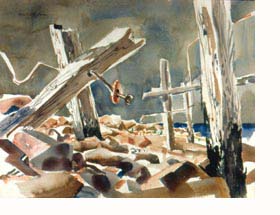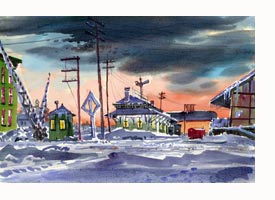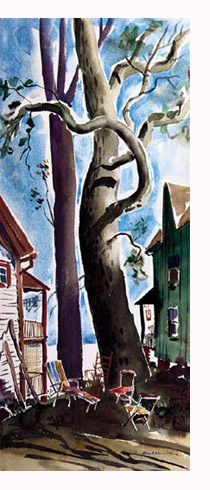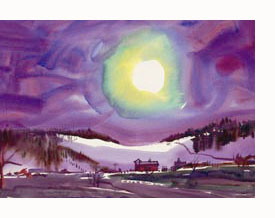|
The Watercolors
Watercolors of John C. Menihan
of John C. Menihan


by
Ron Netsky
Over
a sixty year career, John Menihan was without question one of the
most prolific and prominent artists in upstate New York. As the
region's leading portrait artist, Menihan painted oil, tempera and
acrylic portraits of Rochester's most distinguised citizens, including
Frank E. Gannett, Bishop James E. Kearney, and Federal Judge Harold
Burke. It is almost impossible to visit an area college, university,
or hospital without encountering a John Menihan portrait.
 Menihan
also executed many significant large-scale public works for area
businesses, ranging from 110-foot-long abstract relief mural for
Security Trust Company to a 64-panel mural depicting herbs and spices
for the R.T. French Company. Yet another strong component of Menihan's
oeuvre was liturgical work. He produced a variety of two and three-dimensional
pieces for Rochester area churches and a major stained glass window
for Nazareth College. Menihan
also executed many significant large-scale public works for area
businesses, ranging from 110-foot-long abstract relief mural for
Security Trust Company to a 64-panel mural depicting herbs and spices
for the R.T. French Company. Yet another strong component of Menihan's
oeuvre was liturgical work. He produced a variety of two and three-dimensional
pieces for Rochester area churches and a major stained glass window
for Nazareth College.

 From
the late 1930s to the 1960s, Menihan's works, in a variety of media,
won prizes in the prestigious Finger Lakes Exhibition at Rochester's
art museum, the Memorial Art Gallery. In 1947 Menihan stunned the
art community by winning four first prizes in the Finger Lakes show. From
the late 1930s to the 1960s, Menihan's works, in a variety of media,
won prizes in the prestigious Finger Lakes Exhibition at Rochester's
art museum, the Memorial Art Gallery. In 1947 Menihan stunned the
art community by winning four first prizes in the Finger Lakes show.
 So
active was Menihan in so many different spheres of art that he was
seldom without a major commission. He did, however, find time to
experiment with a variety of materials in the areas of painting,
sculpture and printmaking. But throughout his career, no matter
what long-term projects occupied his time or what media were the
basis of his experiments, Menihan always returned to the medium
with which he felt perfectly at ease: watercolor. So
active was Menihan in so many different spheres of art that he was
seldom without a major commission. He did, however, find time to
experiment with a variety of materials in the areas of painting,
sculpture and printmaking. But throughout his career, no matter
what long-term projects occupied his time or what media were the
basis of his experiments, Menihan always returned to the medium
with which he felt perfectly at ease: watercolor.
 So
energetic and open to exploration was Menihan that even within the
medium of watercolor his work covered a large territory with regard
to both subject matter and style. When painting urban scenes, for
instance, he would often employ a combination of free strokes of
color and expressive line. In his watercolor portraits, Menihan
was capable of an almost photograhic clarity. So
energetic and open to exploration was Menihan that even within the
medium of watercolor his work covered a large territory with regard
to both subject matter and style. When painting urban scenes, for
instance, he would often employ a combination of free strokes of
color and expressive line. In his watercolor portraits, Menihan
was capable of an almost photograhic clarity.  There
is, however, a particular style and a particular area of subject
matter that can be seen as recurring and dominant strains in Menihan's
watercolor paintings. There
is, however, a particular style and a particular area of subject
matter that can be seen as recurring and dominant strains in Menihan's
watercolor paintings.
 The
style is one in which free brushstrokes reign and color is applied
with palpable sense of abandon. Ironically, to paint works with
the sense of freedom that comes through in these watercolors, an
artist actually must be in absolute control of his technique to
the point where every mark made is intuitive and the very act of
defining forms with the brush becomes second nature. The
style is one in which free brushstrokes reign and color is applied
with palpable sense of abandon. Ironically, to paint works with
the sense of freedom that comes through in these watercolors, an
artist actually must be in absolute control of his technique to
the point where every mark made is intuitive and the very act of
defining forms with the brush becomes second nature.
 Works
by Menihan in this unencumbered style often deal with the subject
matter that he handled most beautifully in all media - the everyday
world of seemingly mundane scenes and situations. Works
by Menihan in this unencumbered style often deal with the subject
matter that he handled most beautifully in all media - the everyday
world of seemingly mundane scenes and situations.
 One
way in which Menihan injected freshness and immedicacy into his
work was to paint One
way in which Menihan injected freshness and immedicacy into his
work was to paint  on
the spot, directly in front of his subject. His preception of a
scene- whether it encompassed teetering barns, creaking houses,
city streets or open countryside- was in this way transmitted directly
to the paper without the mediation of sketches, photographs or other
preliminary devices. on
the spot, directly in front of his subject. His preception of a
scene- whether it encompassed teetering barns, creaking houses,
city streets or open countryside- was in this way transmitted directly
to the paper without the mediation of sketches, photographs or other
preliminary devices.
 Whether
they were celebrations of color or studies in subtlety, every scene
taken in by Menihan's eye was filtered through his mind to the hand
that held the brush. In split seconds came a stream of checks and
balances from eye to brain, and then a mark, expansive or tiny,
a tip of the brush lightly tinged with water for a rich stroke or
more heavily loaded with water for a wash. Whether
they were celebrations of color or studies in subtlety, every scene
taken in by Menihan's eye was filtered through his mind to the hand
that held the brush. In split seconds came a stream of checks and
balances from eye to brain, and then a mark, expansive or tiny,
a tip of the brush lightly tinged with water for a rich stroke or
more heavily loaded with water for a wash.
 Watercolor,
as anyone who has painted with it knows, allows no second-guessing.
It's an unforgiving medium that must be applied the right way the
first time. It is precisely this enforced spontaneity and the knowledge
that a painting could become overworked and be easily ruined if
the artist becomes too self-conscious and literal that makes the
finest watercolors wonderful to behold. Watercolor,
as anyone who has painted with it knows, allows no second-guessing.
It's an unforgiving medium that must be applied the right way the
first time. It is precisely this enforced spontaneity and the knowledge
that a painting could become overworked and be easily ruined if
the artist becomes too self-conscious and literal that makes the
finest watercolors wonderful to behold.
 As
a result of this process, Menihan's painted images delicately, yet
perfectly balance the visual information needed to represent the
subject with the loose, energetic strokes of paint that began to
take on meanings of their own in the late 19th and early 20th centuries. As
a result of this process, Menihan's painted images delicately, yet
perfectly balance the visual information needed to represent the
subject with the loose, energetic strokes of paint that began to
take on meanings of their own in the late 19th and early 20th centuries.
 In
Impressionist painting and subsequently in various forms of expressionist
painting - from Van Gogh's heightened color and exaggerated shapes
to Hans Hoffman's works composed simply of color, stroke and form,
devoid of representational content - artists have gratly extended
the sensual reaches of color and form, allowing these elements to
function outside of specific contexts. In
Impressionist painting and subsequently in various forms of expressionist
painting - from Van Gogh's heightened color and exaggerated shapes
to Hans Hoffman's works composed simply of color, stroke and form,
devoid of representational content - artists have gratly extended
the sensual reaches of color and form, allowing these elements to
function outside of specific contexts.
 This
newfound freedom was exploited most prominently in watercolor by
John Marin, who in the first half of the 20th century infused his
urban and rural landscapes with a dynamic energy. With just a few
dramatic stokes, Marin could suggest a vivid urban landscape set
against a dramatic sky. This
newfound freedom was exploited most prominently in watercolor by
John Marin, who in the first half of the 20th century infused his
urban and rural landscapes with a dynamic energy. With just a few
dramatic stokes, Marin could suggest a vivid urban landscape set
against a dramatic sky.  Menihan's
finest work contains an element of shorthand form similar to Marin's,
sending concise visual signals that, although painted with abandon,
are easily decoded by the viewer. The images become, in this way,
somewhat dreamlike: fleeting impressions of scenes that connect
with the deepest parts of us in a manner that precisely defined
work never could. Menihan's
finest work contains an element of shorthand form similar to Marin's,
sending concise visual signals that, although painted with abandon,
are easily decoded by the viewer. The images become, in this way,
somewhat dreamlike: fleeting impressions of scenes that connect
with the deepest parts of us in a manner that precisely defined
work never could.
 When
this style is undertaken by an artist, who does not have the skills
necessary to paint with abandon, the results are stilted and contrived.
In Menihan's watercolors there is a sense of the opposite: freedom,
fluidity and fun. When
this style is undertaken by an artist, who does not have the skills
necessary to paint with abandon, the results are stilted and contrived.
In Menihan's watercolors there is a sense of the opposite: freedom,
fluidity and fun.
 A
perfect marriage between subject and style can often be found in
these works. A stroke left abruptly cutoff becomes an appropriate
sign for the disheveled side of a building. A heavy wash of blue/purple/gray
stands convincingly for rain clouds. Although there is enough visual
information to translate into representational context in Menihan's
watercolors, there is also present, in no small measure, the artist's
autographic stroke, which incorporates the concerns of 20th century
modernism and the purity of painting in an abstract sense. A
perfect marriage between subject and style can often be found in
these works. A stroke left abruptly cutoff becomes an appropriate
sign for the disheveled side of a building. A heavy wash of blue/purple/gray
stands convincingly for rain clouds. Although there is enough visual
information to translate into representational context in Menihan's
watercolors, there is also present, in no small measure, the artist's
autographic stroke, which incorporates the concerns of 20th century
modernism and the purity of painting in an abstract sense.
 Although
their presence is usually implied, figures are often not included
in Menihan's composition. A few swift but sure strokes in the right
place can connote more body language than exists in many artists'
more labored efforts. Although
their presence is usually implied, figures are often not included
in Menihan's composition. A few swift but sure strokes in the right
place can connote more body language than exists in many artists'
more labored efforts.
 As
in the often improvised Irish music that Menhian loved to listen
to, the watercolors come together in a spontaneous manner, each
stroke a reaction to those that came before it. The results are
harmonious compositions that capture the scene depicted in a manner
striking enough to transport viewers, affording them a sense of
the celebration of life that is at the core of John Menihan's watercolors. As
in the often improvised Irish music that Menhian loved to listen
to, the watercolors come together in a spontaneous manner, each
stroke a reaction to those that came before it. The results are
harmonious compositions that capture the scene depicted in a manner
striking enough to transport viewers, affording them a sense of
the celebration of life that is at the core of John Menihan's watercolors.
 
Ron Netsky is Chairman
of the Art Department
 at
Nazereth College in Rochester, NY at
Nazereth College in Rochester, NY

|









